Since I’m getting requests to outline the differences between the made in USA frameset and the made in Taiwan frameset, I thought the subject deserved a full-blown post with 8×10 color glossies, circles and arrows, and a paragraph on the back of each one describing what each one is.*
The obvious difference is where each frame is made and how much it costs. One is made in Taiwan by friends I have known for 20 years. The other is made in San Francisco by a friend I have known for 6 years. The Taiwan made frame’s price is $595 and the USA frame sells for $1600. But wait, there’s more.
Tubing: The Taiwan made frames use a heat-treated 4130 steel double butted tubeset where the US made frames is built with True Temper Verus tubeset that is US made as well.
Frame components: The US made frame is built with US made Paragon Machine Works dropouts and BB shell with a fork crown from Pacenti. The Pacenti fork crown is made in Taiwan, but that’s simply because that’s where the majority of cast parts, including lugs, come from.
Frame finish: The US made frames are finished with a powder coat in International Orange with no clear coat. The Taiwan made frames are painted with wet paint and then clear coated with clear powder coat. This makes the Taiwan frames very shiny and polished looking. Decals on the US frame are sourced from North Carolina’s Screen Specialty Shop.
Geometry: The US frames sport the same geometry as the Taiwan frame with one change. The bottom bracket drop is 5mm lower (70mm) that the Taiwan made frame. This is something I’ve been thinking about changing on the Taiwan frames since the traditional 65ish bb drop for cross frames is based on running 32-35 tires. These frames are typically run with much larger 40-45 tires, so an increased drop will keep the bb height at a reasonable height for clearance and stability.
Unseen details: The Taiwan frames are ED coated prior to painting to rust-proof them. The US made frame has completely sealed tubes with no exterior vent holes and blind bottle/rack braze-ons that are not open to the interior of the tube. This means no moisture can enter the tubes so there’s no need for rust-proofing. The one tube that is open is the seat tube (how else would the seat post fit). The bottom of the seat tube is vented into the bb shell. I spray a bit of Boeshield into the seat tube prior to building of shipping the frame. I also always spread a nice layer of grease around the inside of the bb shell when building a bike to protect the steel from water that will inevitably get into the bb shell if you ride you bike in the rain, which you most definitely should.
That’s about all I can think of at this moment, so I’ll let the following photos do most of the talking. Nope, one more important difference which actually isn’t a difference at all. Since the frame tubing of both the US and Taiwan frame has virtually the same specification, the ride quality should be the same between the two. At some point, I’ll get some time to build one of the US frames for myself and will report back.
One more: On the Taiwan made frames, there is a brazed-on cable stop for center-pull cantilever brakes. I eliminated this cable stop on the US made frame because most owners are going to run the Paul Mini-Moto brake which doesn’t need a stop. Without the stop, the look is much cleaner with the Mini-Moto. However, if someone wants to run canti brakes, the Paul Funky Monkey seat clamp/cable stop is my recommendation.
One more: Weight. Could be important. A 56cm Taiwan made cross frame with all bolts, seat clamp, dropout adjusters…is 4lb. 10oz. The US made frame with steel hanger, all bolts, seat clamp is 4lb. 5oz. That’s mainly due to the lighter dropouts and the lack of a seat stay cable stop. The Taiwan fork with 350mm steerer is 2lb. 7oz. The US fork is also 2lb. 7oz., but that’s with a 400mm steerer tube. The last US made cross bike I built, I cut off 6″ from the steerer and that cut out 6oz.

US made up front, Taiwan made in back
US made rear stay shape. S-Bend chainstays allow use of any crank arm. Maximum 50/34 chainring combo.
Taiwan made stay shape. Big tires fit. Not all crankarms (Dura Ace, Ultegra, 105) fit. SRAM fits, though as does the Sugino OX-601.
Horizontal dropouts on the Taiwan made frames. Note the vent holes. More on that later.
USA made frame sports Paragon Machine Works 1 1/8″ Wright dropouts. Note the lack of vent holes. The replaceable dropout is steel which gives you the best possible anchor for your derailleur and ensures crisp, precise shifting. I also include an aluminum 7075 dropout for those wanting to save a few grams.
Forward facing seat tube slot on the USA frame. The seat post is a very precise (almost tightish) fit. Not that the frame is not sliding off the seat post with no seat clamp.
Rear facing seat tube slot. The seat post fits nicely in the Taiwan made frames, but without that seat clamp, the frame would slip off the clamped post.
Fork crown on the Taiwan frame with vent holes.
Pacenti fork crown on the USA frame. No vent holes.
Brazed dropouts on the US frames. There’s a lot of work brazing and cleaning and filing these dropouts. No vent holes.
The Taiwan frames have the end of the fork leg rounded which lessens the time to braze the tips. Vent holes.
The crimps on the Taiwan frames work, but aren’t pretty.
Nice subtle crimps on the US made frames. Both frame have clearance for 29″ x 1.75″ tires.
(What’s playing: Aretha Franklin See Saw)


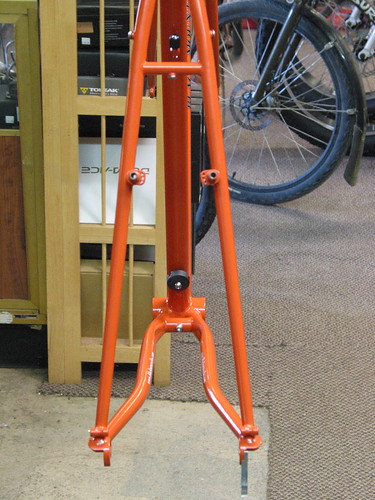
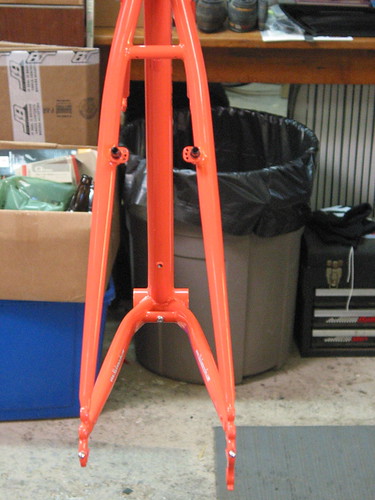
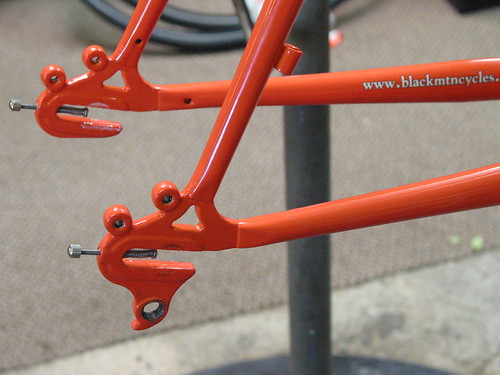
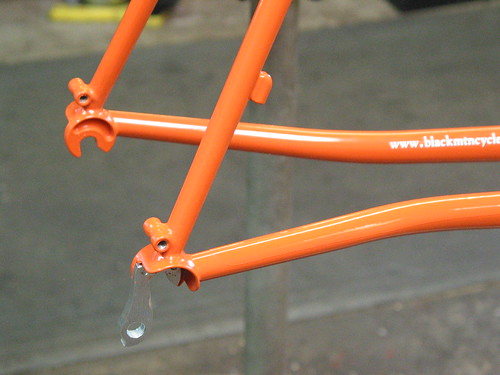
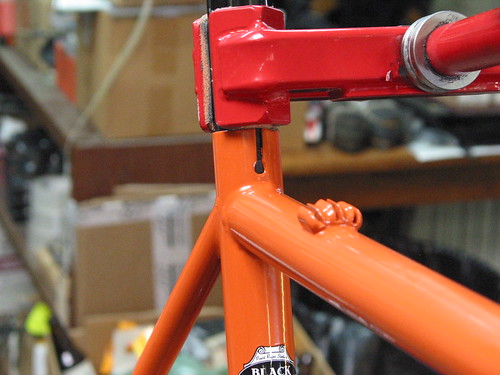
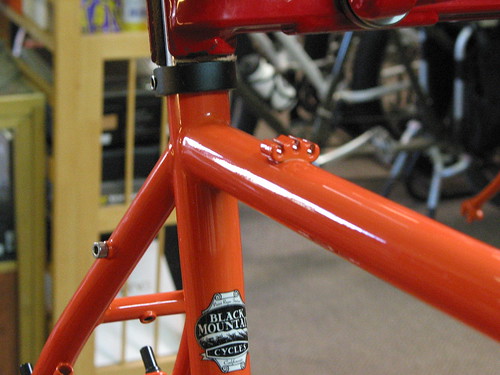
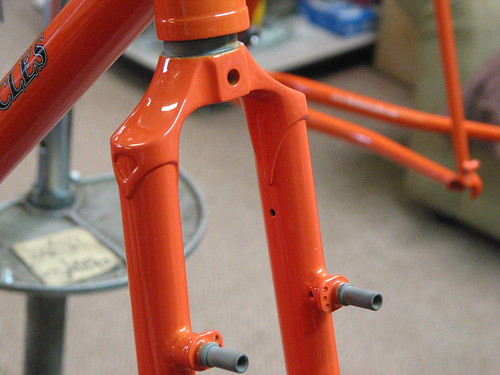
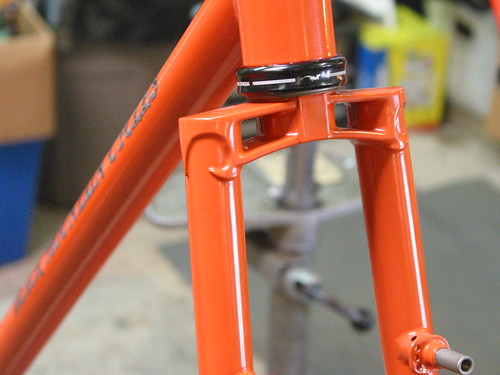
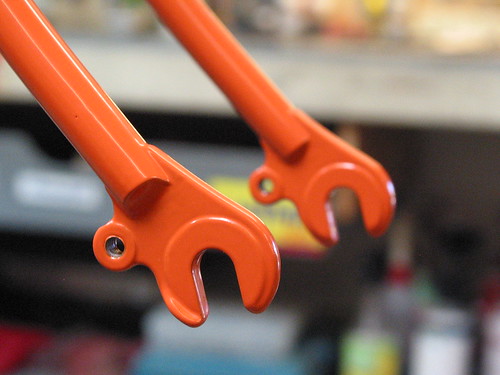
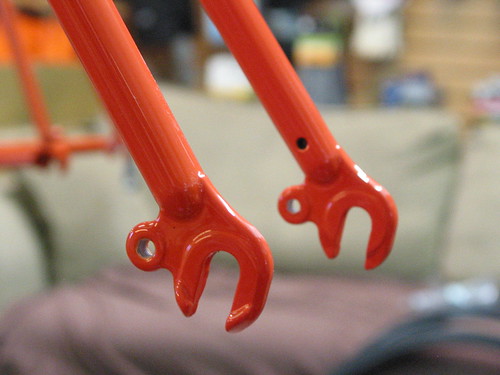
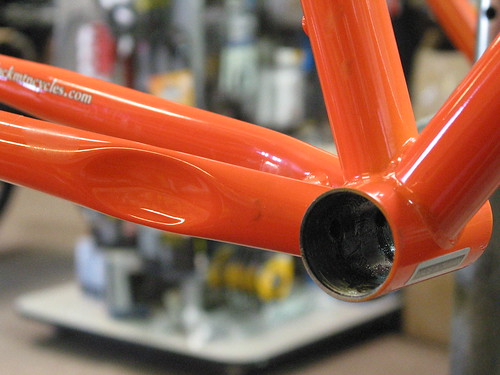
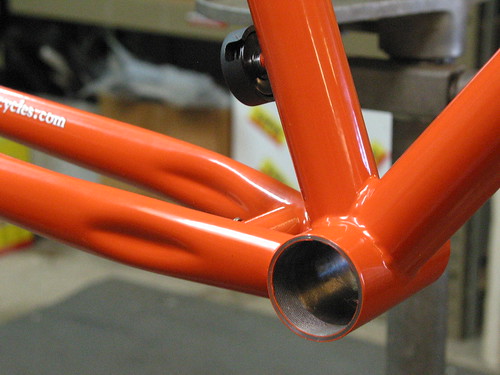
Nice post! A question and a comment: If I wanted a single speedable U.S. made frame, is that an option? And to the crank issue, I have a non-series Shimano compact, (110BCD) crank that at one time had the 50/34T combo, (now running 46/36T), and cleances for that on my Taiwanese built BMC are fine. Not sure why an Ultegra compact wouldn't be the same unless the newer ones have been changed.
Can you say something about how you would set up cantilever brakes on both? It seems like on the Taiwan one you hang a Surly hanger off the seat bolt. On the MUSA one, do you run the seat clamp backwards and hang a Surly? Is that allowed? Do you run a Paul Funky Monkey off the seatpost? Or do you recommend your MUSA customers run Mini Motos?
Bubba: Looks like I have to add one more difference. I eliminated the brazed-on canti cable stop on the US frame since the vast majority of owners plan to use the Paul Mini-Moto brake. For cantilever use, my suggestion is the Paul Funky Monkey integrated seat clamp/cable hanger.
G-T: Those non-series cranks have a wider pedal stance (by only a few mm, but that's enough) than the current and previous generation of Dura-Ace, Ultegra, 105 cranks. There's no issue with clearance with Shimano's CX series of cranks or the Tiagra compact double crank.
Thanks for the excellent post showing and explaining the differences between the frames. It is very helpful.
And to your s/s comment G-T, the current frames would only be single-speedable via a chain tensioner or White Industries Eno Eccentric hub. If at least three people want a frame of the same size with single-speedable dropouts, then we can do it.
Any appreciable difference in weight?
A couple ounces lighter on the fork and 5 ounces lighter on the frame.
Nice EVT repair stand arm.
Thanks Mike! I appreciate the answers.
I know nothing about bicycles, but I really appreciate your Arlo Guthrie attribution. We must be about the same age.
Using a seatpost clamp cable hanger for a rear canti brake makes sense, and of course a steerer tube cable hanger mounted above the headset works for a front canti, but… if you want to use a fork crown mounted cable hanger to help fight brake shudder with a front canti, you need a hole in the fork crown. The MUSA fork doesn't have one. Is it feasible to drill one, or would that be ill-advised?
Good catch on the drilled crown. The back side of the crown is drilled and tapped for a 5mm bolt. No problem to drill out the front of the fork crown if someone wanted to run a fork mounted cable stop.
Now you have added a link to the Paul Components website, you've brought my attention to Paul offering a limited pre-order for Orange Anodized parts! Would Orange Anodized parts on a Black Mountain Frame be Einstein, or Frankenstein?
Bubba, a little Frankenstein, I think. I actually have a bike's worth or orange brakes from their last "limited" run of orange. Not the greatest rendition: http://www.flickr.com/photos/46195580@N03/9418923244/
"The bottom bracket drop is 5mm lower (70mm) that the Taiwan made frame."
This seems like a good idea to me. The jacked up bottom brackets on bikes like these (Surly CC, Soma DC, etc) make no sense when the whole point is to use big tires.
I really like the blog and the tech info therein.
Vent holes are good.
Elegant. Any chance of plated dropouts on the USA frames/forks?
Plated – no. Plating is super expensive and difficult to manage in the states. A better option would be to use stainless dropouts and mask off during powder coating.
Stainless dropouts would add a very attractive element of distinction to the frames.